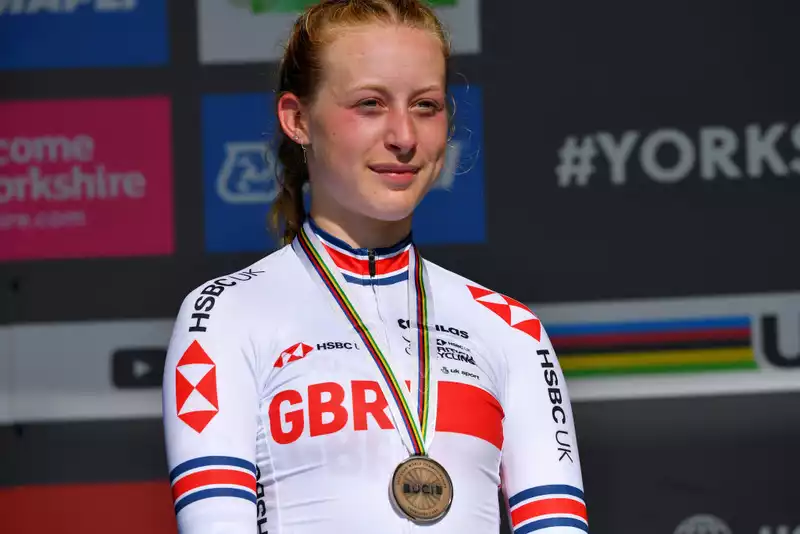Elinor Backstedt (Trek-Segafredo) has resumed wearing an orthopedic boot and light training after wearing a cast on her foot for five months to treat a shear fracture she suffered in a mountain bike fall in May.
In an interview with Cycling News, the 18-year-old said she still has pain when rotating her foot to pedal in and out and walks with a slight limp.
"It was a big, big, big fracture and it took a long time to get the cast off. 'From May to July I was in a cast up to the middle of my thigh, and I had to wear a boot until September. I had to stabilize everything until they thought it was safe to bend my leg
"It took a long time to heal. It was a spiral fracture of the tibia, and I had broken the same leg before, so it was a little weak. From the top of the ankle to the middle of the shin, rather than a clean break, all I can say is that it goes all the way around the bone."
Trek-Segafredo confirmed in May that Backstedt, the youngest rider on the women's world team, broke her tibia in a mountain bike crash.
Backstedt's father, Magnus, said he was with her while she was mountain biking in a forest near her family home in South Wales. They were descending a steep off-road trail at about 10 km/h when the front wheel lost traction and slipped and fell.
Backstedt was taken to the nearby Royal Glamorgan Hospital, where an X-ray showed a spiral fracture of the tibia. After consulting with doctors and family members, it was decided that the broken leg would not be operated on, but would be treated with a cast and leg boot.
"There was talk of pinning it, but because of the different type of fracture, they would have had to put a pole through the knee, through the heel, and into the tibia. That could have caused a knee injury. Due to their age, they wanted it to heal back to normal. Surgery might have been faster, but it might be worse in the long run. After a lot of discussion, we decided against surgery," Backstedt said.
"Now I can take the boot off and ride a little; I'm about 98 percent recovered. I still limp when I walk and clip in and out of the pedals hurts. In terms of pain, I'd say I'm almost back to normal, but I can't train as much as I could. But that's okay because you have to start somewhere
"It will be slow and I want to make everything as strong as possible. I am still young, so there is no need to rush and cause more problems in the future. It's important to get stronger day by day and slowly get back to full fitness."
Backstedt is in the first year of a two-year contract with Trek-Segafredo and says the team has been very supportive during his recovery.
"They were really great. If I had any concerns, there was always someone on the other end of the phone, and the team doctor looked at my x-rays and gave me a second opinion.
"I'm disappointed that I didn't get to race this year, but I'm only 18 and I have a long career ahead of me.
Buckstedt, while being sensible about his recovery plan, aims to return to racing as soon as possible. She believes that returning to racing so soon after an injury without spending the proper time training and preparing for the demands of racing at the World Tour level could be demoralizing.
"I trust my team, my coach and my physio and I am working hard to get back to where I was before the accident.
She hopes to be back racing in time for the spring classics, especially the first ever women's Paris-Roubaix next April, but understands that is five months away.
"I think having that race is a big step forward for women's cycling. It's a race I've wanted to make happen for a long time, and I've always hoped to run that race one day," Backstedt said.
"It's a step forward for equality in the sport. It is the biggest one-day race of the year. I would love to run the race next year, but it's still a few months away."
The inaugural women's Paris-Roubaix was a surprise addition to the revised Women's World Tour calendar this October, but was postponed due to COVID-19. The race is now set to take place for the first time in April.
The ASO announced the route details in September, with a starting point in Denain, south of Roubaix. The peloton will run 116 km and finish at the famous Roubaix Velodrome, with 17 cobblestone sections, beginning just 20 km into the race.
Two sections are of maximal difficulty: the Mont-en-Pevere and Carrefour de l'Arbre, and the cobblestones take up 29.5 km.
"I did the Mini Paris-Roubaix when I was 15, but there weren't that many sectors. 'It wasn't a race, it was a training run. The cobblestones are pretty barbaric and you don't see that in other parts of the world. I can assure you that they are deadly. When it rains they are slippery and muddy, but to run on them is something special."
Backstedt's parents were both professional cyclists. Father Magnus Backstedt won Paris-Roubaix in 2004, and mother Megan Hughes was the 1998 British road race champion.
"Both my parents are very excited that there will actually be a women's Paris-Roubaix.
"My dad was speechless. He was thrilled that my sister [Zoe Backstedt] and I would be able to run in a race that my father loved so much. He may one day be commentating on our race or watching us race. He was so happy it was happening."
.

Comments